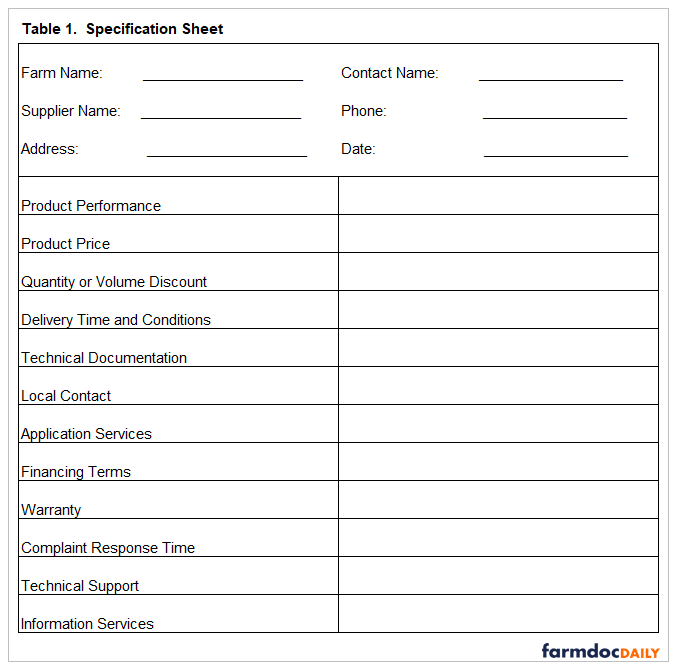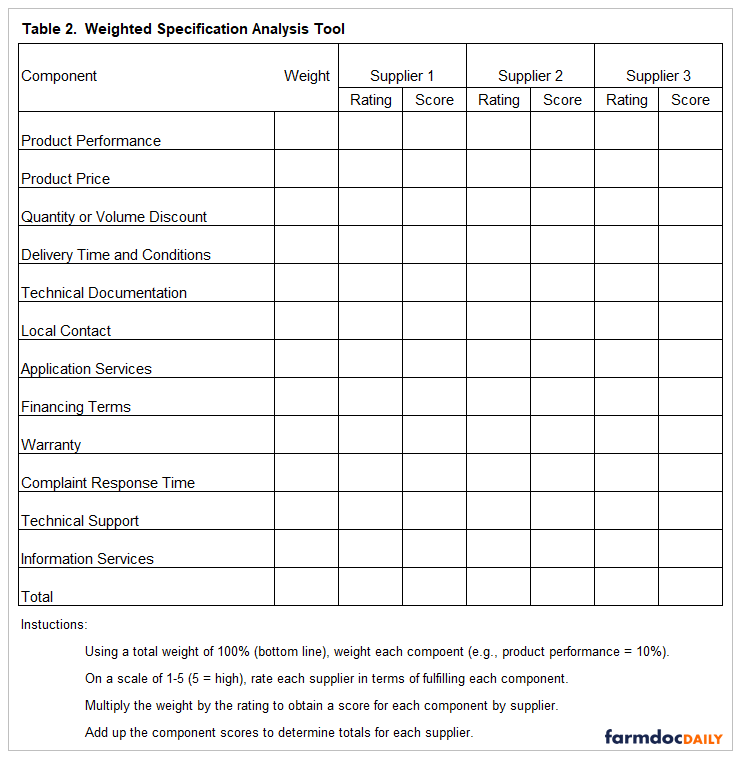Buying Inputs in the Current Business Climate
Grain farmers are facing significantly lower crop prices and incomes in 2025 compared to previous years which have resulted in intense pressure to lower costs through negotiations on cash rents and purchased inputs. Much of this negotiation has focused on price – farmers are asking for price reductions, but suppliers of fertilizer, seed, and chemicals are hesitant to adjust prices down. In many cases suppliers have laid in inventories at costs that provide little flexibility to reduce prices without dramatically compressing their margins. This article updates the discussion of critical input purchase components and specification sheets found in Boehlje and Downey (2015).
Certainly, price is a critical component of the purchase decision. But there is much more to the decision, including information, service, trust, and availability. More specifically, critical components of any purchase decision are:
- Product performance – effectiveness of the product in enhancing or protecting yield and evidence/documentation supporting the performance claims.
- Product price – net price including transportation/shipping charges and any service fees.
- Quantity/volume discount – any price discounts or service fee reductions that depend on quantity purchased or packaging/budling with the purchase of other inputs.
- Storage, delivery time, and conditions – when and how the product will be delivered, storage arrangements, and penalties and/or back-up if delays occur.
- Technical documentation – product performance documentation and details of product specification including quality characteristics.
- Local contact – name and contact information (cell phone, e-mail, etc.) of the specific person to contact if problems occur in fulfilling the purchase agreement or in the efficacy of the product.
- Application services – cost and performance specifications including timing of any application or other services.
- Financing terms – financing or credit terms offered including cash discounts, interest rates, repayment terms, and the approval process.
- Warranty – performance guarantees and terms of reimbursement for non-performance including documentation requirements and party responsible for servicing warranty claims.
- Complaint response time/process – procedure for filing complaints concerning product/service efficacy or effectiveness including process and time delays in response/resolution.
- Technical support – availability of technical support to answer questions concerning product performance and efficacy including process to contact technical support personnel.
- Information services – availability and provider of any information or data analysis services including fees charged for such services and contact person.
One way to more systematically think about the critical components of the purchase decision is to use a specification sheet. Table 1 illustrates a specification sheet on which a buyer may summarize information they need to obtain from suppliers on the critical components of the buying transaction.
It can be helpful to decide in advance how important each of the components are to the purchasing decision. For example, in financially challenged times, product performance or price may be far more important than technical documentation. Some components may be mission critical, while others may have a negligible impact on the decision. By giving a weight to each component of the decision a buyer will have a better basis for comparison.
Each alternative supplier can then be rated on the 12 critical components, and their scores for each component can be tallied. Table 2 illustrates how a weighted specification analysis tool could be used to evaluate and compare alternative prospective products/suppliers.
It’s important to remember that solid relationships with suppliers may provide benefits beyond individual components of a single purchase. A strong relationship may open the door for cost savings in other parts of the business. For example, a supplier may have less bargaining room for a single product than they do if more than one product is purchased.
Other considerations include the urgency of the immediate need, the important of price transparency, and future need. The need for a quick response may limit the ability to compare multiple suppliers, because it takes time to gather information, answer questions, and make comparisons. A buyer my want to consider how wide the potential list of suppliers should be. Sometimes its helpful to have a frank discussion with suppliers to understand the cost structure behind an offer. This conversation may lead to creative methods for reducing supplier cost that could translated into savings for the buyer. Direct delivery to a convenient site could be an example of this. Finally, a buyer should consider their own future needs. A purchase that drives margins so low that the supplier can’t survive could lead to less flexibility and more expensive purchases in the future.
References
Boehlje, M. and S. Downey. “Buying (Selling) Inputs in the Current Business Climate.” Center for Commercial Agriculture, Purdue University, September 2015. https://ag.purdue.edu/commercialag/home/resource/2015/09/buying-selling-inputs-in-the-current-business-climate/
Disclaimer: We request all readers, electronic media and others follow our citation guidelines when re-posting articles from farmdoc daily. Guidelines are available here. The farmdoc daily website falls under University of Illinois copyright and intellectual property rights. For a detailed statement, please see the University of Illinois Copyright Information and Policies here.









